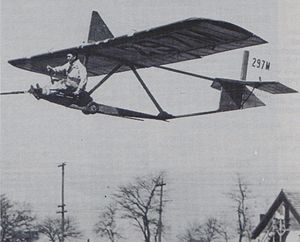- Detroit G1 Gull
-
G1 Gull G1 Gull on tow Role Primary glider National origin United States Manufacturer Detroit Aircraft Corporation Introduction circa 1930s Status No longer in production Number built At least three The Detroit G1 Gull is an American high wing, cable-braced primary glider that was manufactured by the Detroit Aircraft Corporation during the Great Depression.[1]
Contents
Design and development
The Gull G1 was developed by Detroit Aircraft as an inexpensive aircraft for the Depression. Detroit Aircraft later sold the rights to Stone Aircraft, who sold plans for the aircraft for amateur construction.[1]
The Gull is built from wood, with the tail and wing surfaces covered in doped aircraft fabric. The wing is cable braced from a kingpost. The fuselage consists of a simple structure to which the seat is attached. The pilot sits on the completely open seat, with no windshield. Controls are conventional three-axis. The landing gear consists of two small wheels, with the lower fuselage acting as a skid.[1]
The Gull was reportedly type certified, but no record of the type certificate is on file with the Federal Aviation Administration.[1][2]
Operational history
One Gull was started before the Second World War by Peter Eyrud of Walla Walla, Washington, but not completed. This aircraft was purchased by Peter M. Bowers who completed and flew it. Bowers documented the aircraft project in an article in the March/April 1957 edition of Soaring Magazine entitled Don't Build a Primary.[1]
In 1983 two other Gulls were reported to be in storage awaiting restoration.[1]
In May 2011 there were two G1 Gulls registered with the Federal Aviation Administration in the USA. One was in the Kansas Aviation Museum and the other was still registered to Peter M. Bowers, even though he died in April 2003. Soaring Magazine reports that this aircraft too is actually in an unnamed aviation museum.[3][4]
Aircraft on display
Specifications (G1)
Data from Soaring[1]
General characteristics
- Crew: one
- Wingspan: 38 ft (12 m)
- Wing area: 170 sq ft (16 m2)
- Aspect ratio: 7:1
- Airfoil: USA 35
- Empty weight: 200 lb (91 kg)
- Gross weight: 400 lb (181 kg)
Performance
- Maximum glide ratio: 8:1 at 30 mph (48 km/h)
- Wing loading: 2.36 lb/sq ft (11.5 kg/m²)
See also
- Aircraft of comparable role, configuration and era
- Elliotts Primary EoN
- Jongblood Primary
- Schweizer SGP 1-1
- Stamer Lippisch SG-38 Zögling
- Related lists
References
- ^ a b c d e f g Said, Bob: 1983 Sailplane Directory, Soaring Magazine, page 40. Soaring Society of America November 1983. USPS 499-920
- ^ Federal Aviation Administration (May 2011). "Type Certificate Data Sheets Inquiry Results". http://www.airweb.faa.gov/Regulatory_and_Guidance_Library/rgMakeModel.nsf/MainFrame?OpenFrameSet. Retrieved 7 May 2011.
- ^ a b Federal Aviation Administration (May 2011). "Make / Model Inquiry Results". http://registry.faa.gov/aircraftinquiry/NNum_Results.aspx?NNumbertxt=41775. Retrieved 7 May 2011.
- ^ Federal Aviation Administration (May 2011). "Make / Model Inquiry Results". http://registry.faa.gov/aircraftinquiry/NNum_Results.aspx?NNumbertxt=52Y. Retrieved 7 May 2011.
Lists relating to aviation General Aircraft (manufacturers) · Aircraft engines (manufacturers) · Airlines (defunct) · Airports · Civil authorities · Museums · Registration prefixes · Rotorcraft (manufacturers) · TimelineMilitary Accidents/incidents Records Categories:- United States sailplanes 1930–1939
- Detroit Aircraft Corporation
Wikimedia Foundation. 2010.

